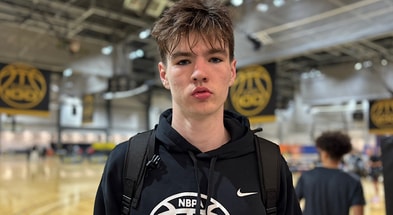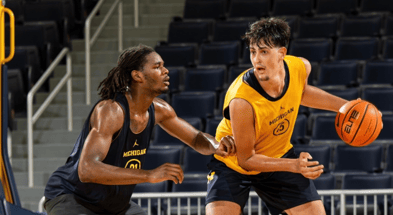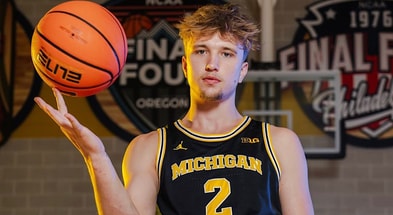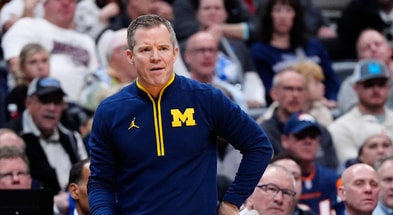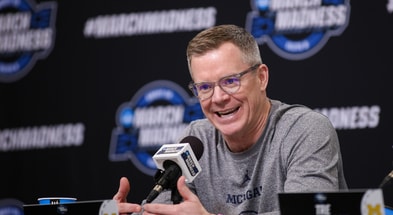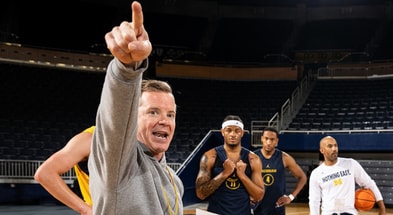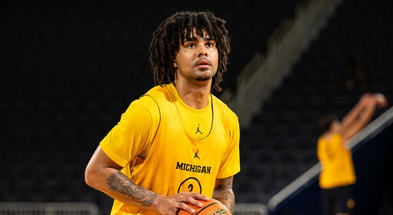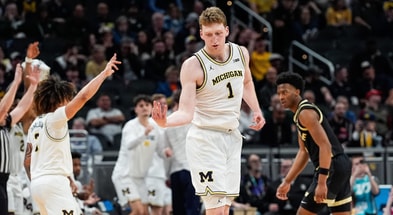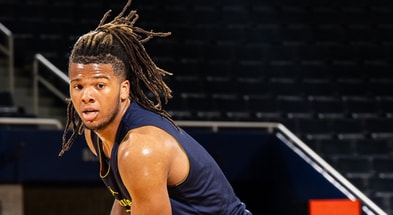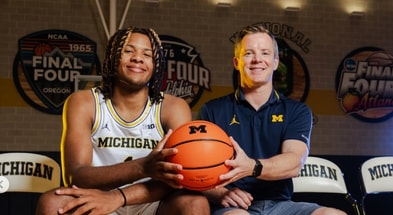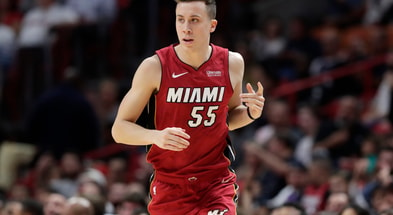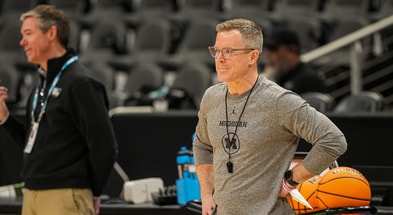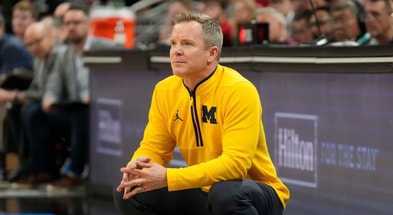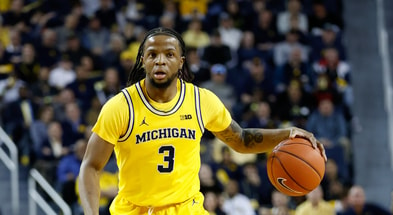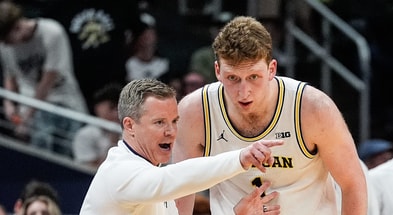Big Ten basketball preview: Breaking down all conference teams in depth, Part II

Michigan basketball media day is tomorrow, and Michigan assistant Phil Martelli is filling in for Juwan Howard. The head coach is still recovering from heart surgery but doing well, expected to be back on the bench later this year.
Our Jeff Schiller (MHoops1) breaks down the Big Ten teams in depth and will provide a projected order of finish later. Here are the next four teams (in no order) after he previewed Ohio State, Purdue, Penn State, and Northwestern last week.
RELATED: Big Ten basketball preview, part I: Breaking down all conference teams in depth
Wisconsin Badgers
Coach Greg Gard has his entire starting five back from a team that started fast before a 12th-place conference finish and Wednesday exit in the Big Ten Tournament led to an NCAA tournament snub. Transfer AJ Storr (St. Johns) provides a wing sniper, something the Badgers lacked last season. The floor for Wisconsin may be relatively high because of experience and continuity; the question is whether the ceiling is much higher than the floor.
Last year, Wisconsin finished 131st nationally in offensive efficiency (per barttorvik.com). Perhaps most disturbing is that aside from not turning the ball over, where the Badgers were elite (2nd nationally), Wisconsin was bad to atrocious in every other significant offensive category — 290th in effective field goal percentage, 337th in offensive rebound percentage, 342nd in rate of getting to the free throw line per shots attempted, 164th in 3-point percentage, 320th in 2-point percentage, 224th in assists per basket percentage, and 286th in free throw percentage. Those numbers are really bad. And they were bad despite unexpectedly large contributions from center Steven Crowl, shooting guard Connor Essegian, and even wing Max Klesmit.,,
So why was Wisconsin’s offense that bad? Simply put, it was because their putative stars were bad. Wisconsin had two guys who appeared on pre-season conference honors lists, forward Tyler Wahl and point guard Chucky Hepburn. Neither came close to living up to billing or even to playing well. Wahl, who admittedly had some mid-season injury issues, was flat out bad (93 efficiency rating with 100 being average and an effective field goal percentage of 43.8%, which is terrible for an inside player). Hepburn was also below average in efficiency. He shot it well from 3 (40.4%), but was bad inside the arc (35.7%) and most disturbingly, had less than 100 assists on a team with no other ball distributors. When the so-called stars play badly, it’s very hard to overcome that. Wisconsin did not do so.
The key question for Wisconsin this season is whether Are Wahl and Hepburn really stars, or were they just made to look better the year before when Johnny Davis was the focal point of the offense? Can overlooked recruits Crowl and Essegian develop into stars? Greg Gard needs to find a guy or guys who play at an all-conference level (not necessarily first team, but at least top 10 or 12 guys in the conference), because teams without a real first option guy generally struggle in Big Ten play.
It likely all comes down to Hepburn. He’s the only player the Badgers have who can be a scorer and a creator off the bounce. This is not an offense which has other guys who can create their own offense on a regular basis, so Hepburn has to be that guy, and he hasn’t done it to date. With Johnny Davis, it didn’t matter. Now, it does.
Nebraska Cornhuskers
In his fourth season in Lincoln, Fred Hoiberg finally started to turn things around after a miserable start (24-67 overall; 9-50 in conference) filled with nomads streaming in and out of the program. Last year’s Husker squad finished 16-16 (9-11 in conference), and several key players return from that team including Keisei Tominaga, a fantastic shooter at all levels (62/40/89) and quite possibly the most entertaining player to watch in the country. He is joined by veteran wings C.J. Wilcher, Juwan Gary and Jamarques Lawrence, and a host of transfers who were productive at former spots including combo guard Jarron Coleman (Ball State), bigs Rienk Mast (Bradley) and Josiah Allick (Mew Mexico), wing shooter Bryce Williams (Charlotte), and combo guard Ahron Ulis (Iowa). Nebraska has depth. Fit and playmaking from amongst these options will determine whether the Huskers move up the Big Ten standings.
As to playmaking, Nebraska ran a unique offense last year, which operated through center Derrick Walker and then, secondarily, point guard Sam Griessel. Walker was a poor man’s Ethan Happ, a big who could catch the ball away from the basket and back down/dribble drive his way into a shot near the hoop (which he converted at almost a 60% clip) or facilitate for teammates. Griessel was also somewhat unique, a 6-7 somewhat ponderous point guard who used his height to get into the lane against smaller opponents and convert or facilitate. Those guys were the only two guys on Nebraska who were even average passers/playmakers for others, but their abilities and styles freed up Tominaga from any real ballhandling/playmaking duties (he had only 22 assists on the year in over 800 minutes as a 6-2 guard) and allowed him to do what he does best — run off screens, cut to the basket, and attack closeouts.
Without facilitators, this becomes more difficult. Perhaps Coleman, the transfer from Ball State, can fill part of the playmaking void, maybe even the coach’s son, Sam Hoiberg, who had a few late season moments (although he had a microscopic assist percentage and functioned strictly as a shooter last season), but playmaking is a huge concern as the season begins.
A second question also involves the absence of Walker and Griessel. Nebraska’s strengths on offense last year were 2-point percentage (55th nationally) and Tominaga’s shooting, and even with those strengths, the Huskers were a dismal 139th nationally in offensive efficiency. Walker and Griessel, along with Tominaga were Nebraska’s most prolific inside scorers by a wide margin. Here, the options are more plentiful—transfers Mast and Allick were quite competent in this area, albeit at lower levels and without Walker’s length and passing ability, and returnees Gary and Wilcher are athletic finishers—but all will be doing so in a different offensive structure than the one in which they previously performed. How that works is another key question to be resolved.
It was no accident that Nebraska’s late season surge (6-3 with wins over 3 NCAA teams and 2 NIT teams) coincided with an absolute breakout by Tominaga (20.3 points per game after averaging 10.6 in the 23 games prior thereto). Tominaga is the key, and he is a guy who needs to have others whose games work with his unique, frenetic, constant motion style. It remains to be seen whether the new nucleus can/will do that.
Overall, Nebraska is a team that rates to be very inconsistent this year. While college basketball is now replete with teams which introduce a ton of newcomers into the equation, relatively few of these infusions involve changing the way teams play on the offensive end. To Hoiberg’s credit, he has always been a coach who adapts what he does to the personnel he has to work with, and at Iowa State, he had a lot of success doing so. With this team, it is more unclear. Keeping Tominaga healthy and at peak efficiency will tell a lot of the tale of whether Nebraska can move up and even challenge for an NCAA berth or whether the Huskers will again be spoilers.
Minnesota Golden Gophers
Coach Ben Johnson finally has some roster continuity as he heads into his third season in Minneapolis. A 4/5 combo and former top 40 recruit, Dawson Garcia, is back for a second season after putting up some impressive counting stats — 15.3 ppg, 6.7 rpg, 2.2 apg and 34.5% from 3-point range. Three sophomores, big man Pharrel Payne, guard Braeden Carrington, and wing Joshua Ola-Joseph, got valuable experience last year and should be improved. Minnesota has added up-transfer guard Mike Mitchell, Jr. from Pepperdine, who shot 44% from 3 last year (and 40% the year before) on heavy volume and has dished out over 150 assists in each of his two seasons. That’s a core Johnson has not had since he took over in Minnesota.
Top 10
- 1New
OL has something to prove
Michigan has to step up in the trenches
- 2
News and views
How will RB carries be divided?
- 3Hot
New Mexico coach
Jason Eck talks Bryce Underwood, Michigan
- 4
'1a and 1b' at RB
Jordan Marshall or Justice Haynes?
- 5
Flip target
Penn State commit considering Michigan
Get the Daily On3 Newsletter in your inbox every morning
By clicking "Subscribe to Newsletter", I agree to On3's Privacy Notice, Terms, and use of my personal information described therein.
At the same time, significant question marks jump off the page when looking at the Gophers’ prospects. Ironically, one such question involves whether Garcia, Minnesota’s best player, and Mitchell, their second-best guy, are players who contribute to winning basketball as opposed to simply piling up stats. This is Garcia’s third stop — Marquette, where he started and played one year, improved dramatically after he left (13-14 to 19-12 and an NCAA tournament bid). UNC, where he then transferred and played a half season, transformed from a bubble team while he was there to a team that reached the NCAA finals after he departed, and Minnesota, where he played last season, stayed flat and bad despite his addition while seeing an extreme drop-off from Jameson Battle, the guy who was supposed to create a two-headed monster with Garcia.
Battle left is now at Ohio State. Meanwhile, Mitchell, Jr., despite his impressive stats, played for a team that went 3-29 in West Coast Conference play the last two seasons. Maybe those are all coincidences. Maybe Mitchell’s losing can be blamed on lack of talent around him. Maybe the fits weren’t right, or the coaching was suspect. However, at a minimum, there is enough data to create questions about whether Minnesota’s top guys can help Johnson win more frequently, or whether they will simply be guys who score a lot on a bad team.
The second big question is how good Payne, Carrington and Ola-Joseph will become. Each got a lot of experience and put up some numbers as a freshman, but each will also have to take a jump to be a true Big Ten starting level player at somewhere other than a cellar-dweller power- conference program. None was a heralded recruit, and their ceilings remain a mystery. Will one or more take the “sophomore leap?” The answer to that question is critical for the Gophers.
The reason that most if not all of the above questions need to be resolved in the affirmative is that Minnesota is largely out of options after that group. Elijah Hawkins, a diminutive transfer from low D1 Howard, is an interesting piece, a guy who scorched the nets from 3-point range against D1 opponents last year (44.4%) and dished out a ton of assists, but who was out-of-control a lot (well over 100 turnovers each season)—he could even start and will certainly be a significant rotation piece. Otherwise, there is a lot of wishin’ and hopin’ in terms of depth.
Minnesota basketball will be improved, but the bar was set so low last season (number 216 in the kenpom rankings, ahead of only Cal amongst power conference teams) that improvement may not equate to a jump up the Big Ten standings. In addition to all the other questions, concerns remain about Ben Johnson, a surprise hire 2 ½ years back for his first head coaching position. There’s some ability on the Minnesota roster. Whether Johnson, who was hired as a recruiter, can bring it together and develop guys who came in without recruiting accolades will be on sharp display. The guess here is no —Minnesota will beat some teams in conference play but will again appear at the bottom of the Big Ten standings.
Maryland Terrapins
The Terps return second team All-Big Ten point guard Jahmir Young, as well as interior starters Donta Scott and Julian Reese from last year’s surprising and schizophrenic squad (10-0 at home in Big Ten play; 1-9 on the road) which reached the round of 32 at the NCAA tournament. Young is an unorthodox player who is very left-handed and not much of a perimeter shooter (31.1% from 3) but nonetheless manages to be very efficient even as a high usage player. If he continues that efficiency and stays healthy, Maryland should be extremely competitive and may produce at the level It did last season. However, as with most Big Ten programs, Kevin Willard’s team will have to confront several significant question marks.
The first is wing play and shooting from the wing. Maryland lost every single wing player who played significant minutes last season and is replacing those players with freshmen Deshawn Harris-Smith, Jamie Kaiser and Jonathan Lamonthe, a transfer from Indiana (Jordan Geronimo), and two lightly played holdovers (Noah Batchelor and Jahari Long). Harris-Smith, who played alongside Michigan’s Dug McDaniel in high school and Kaiser are highly touted (numbers 27 and 75 in the 247 composite rankings), and Kaiser is billed as a shooter, something the Terps desperately need, but both are unproven at the college level, and we have seen highly touted freshmen struggle to acclimate to college hoops. Geronimo is extremely athletic but a complete non-shooter. Long shot it well in limited minutes as a freshman, while Batchelor, who came in with a shooting rep, struggled to adjust in an even smaller role, but both are totally unproven.
From these facts, the questions are obvious. Which, if any of these players, will step up and provide quality wing play and shooting? Can any replace Hakim Hart, a versatile and effective player for the last three seasons in College Park, who has now moved on to Villanova? Can Maryland’s wings shoot it well enough to space the floor for Young and their inside starters? The answers to these questions will be crucial to Maryland’s success or lack thereof.
The other major question is depth at the 1 and 5 positions. There is literally no back-up on the roster for Young. The back-ups at the 5 are even less proven than the wing back-ups, and there are no newcomers with the resume of Harris-Smith. Reese is foul prone, averaging over 5 fouls per 40 minutes played in his Maryland career. An injury to Young would be totally devastating to the Terps. An injury to Reese would be only slightly less so.
It is hard to know what to make of Maryland. Their profile last year was one of a team with no special strengths or categories where team efficiency ranked highly, and no alarming weaknesses, especially on the defensive end. It rates to be similar this time around. If the Terps can perform in the Xfinity Center at a level even close to what they did last year, similar or even better results will be on tap. That said, there is a bit of a house of cards element to this team.

